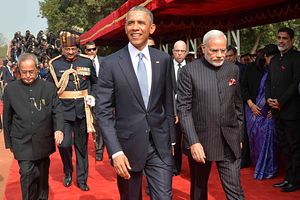The arrow is pointing up in the U.S.-India relationship. Whereas ties between the world’s oldest democracy and the world’s biggest democracy had long been long characterized by mutual suspicion, optimism is now the dominant theme.
Indeed, in an era of American political polarization, support for the U.S.-India relationship is among the few policy issues on which Democrats and Republicans are united. Support for the bilateral relationship is strong in New Delhi as well. Indian Prime Minister Narendra Modi’s June 2016 speech to a joint meeting of the U.S. Congress was, as Indian-American journalist Tunku Varadarajan put it, the “clearest Indian promise to date of a 21st-century alliance with the U.S.” The George W. Bush administration, in negotiating the civil nuclear deal, opened the door to greater U.S.-India cooperation on a variety of issues. Yet it was President Barack Obama who seized upon the opportunity presented by the election of Modi to propel the relationship forward and make the ties between the U.S. and India truly strategic.
In a few short years, the Obama administration has achieved much with its counterparts in India. The United States named India a “major defense partner” and Prime Minister Modi welcomed a strong American presence in the Indo-Pacific region. On energy, Obama and Modi revived a long-stalled deal for the United States to build nuclear reactors in India, not to mention announcing a series of joint green initiatives. And on trade, Modi ratified the WTO Trade Facilitation Agreement.
Yet for all this progress, there remains much to accomplish, and the upcoming change in U.S. administrations will test the relationship. Given these, both sides have a number of challenges they will have to address.
The first challenge is maintaining enthusiasm for the working level U.S-India engagements. Successive American presidents have pushed the U.S.-Indian relationship forward. Yet while senior figures in the United States and India lean in, their respective bureaucracies too often lean back. For this reason, both governments must pursue not only glitzy head of state visits, but also sustained and regular engagement at the working level, where policy experts can have substantive and frank discussions on the tough issues. The bilateral fora that have proliferated in the Obama years–like the Strategic and Commercial Dialogue and the Economic and Financial Partnership Dialogue–are a good start. But the next administration must ensure that these types of engagements become routinized, signature events that endure even as governments come and go.
The second is pushing ahead on the tough issues in the economic and commercial relationship. Over the past several years, India has taken important steps to open its market to foreign investment, to include raising foreign direct investment (FDI) caps across several remaining industries. These reforms have paid off. In 2015 alone inward FDI increased 26 percent, suggesting that Prime Minister Modi’s bold initiatives, like “Make in India,” have caught the eye of global companies. More recently, India’s parliament passed the Goods and Service Tax, which, if implemented properly, will create greater predictability in India’s tax regime and make it easier to conduct business in the country. However, there is even more to achieve. Take, for example, the U.S.-India Bilateral Investment Treaty (BIT). Eight years into negotiations, the two sides remain apart on intellectual property issues, among other things. The next administration must redouble its efforts to conclude the U.S.-India BIT and push ahead in other challenging areas, such as Indian government procurement processes and U.S. H-1B/L visas. Fortunately, whoever succeeds Obama will have a genuine partner in Modi, whose government has demonstrated a commitment to opening the Indian market and improving economic and commercial ties with the U.S.
The final challenge is managing the U.S.-India-China trilateral relationship. The vast improvement in the U.S.-India bilateral relationship over the past several years represents one of the Obama administration’s great foreign policy achievements. Yet the warming of ties between Washington and New Delhi causes anxiety in Beijing, which fears that the burgeoning Indo-American partnership could serve to constrain China’s rise. The challenge for the next administration, then, will be fostering continued cooperation with New Delhi without creating an unmanageable security dilemma between the United States and India on the one hand and China on the other. The next administration should seek to build upon recent progress in the U.S.-India relationship while extending an open hand to China whenever possible.
There are powerful forces pushing the United States and India together: a mutual interest in maintaining stability in the Indo-Pacific, shared concerns about terrorism in South and Central Asia, economic opportunity, and democratic values. The confluence of these factors has led some to suggest that the two countries are destined to be partners. This may or may not be the case, but it is true that the United States has much to gain strategically and economically from close ties to India; the optimism is justified. The next administration must above all resist complacency and not content itself with progress already achieved.
Michael Goldfien is a Campaigns Fellow at Young Professionals in Foreign Policy, and has an MA in International Policy Studies from Stanford University.

































